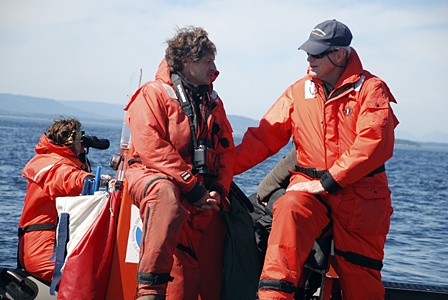The biggest threat to waterways isn’t waste from major industries or factories – it’s what we put down our drains, use to clean our cars, and slather onto our bodies.
Part-time Orcas resident Hedrick Smith, a Pulitzer Prize-winning former New York Times reporter and editor as well as an Emmy award-winning producer and correspondent, investigated the impact of modern life on our waters in his new Frontline documentary “Poisoned Waters.” The two-hour report examines America’s track record on cleaning up its waterways since passage of the Clean Water Act in 1972, using two great coastal estuaries, Chesapeake Bay and Puget Sound, as case studies.
Smith picked the two areas because of their extraordinarily rich ecosystems. He and his wife Susan Zox also have a home near Chesapeake Bay.
Smith started the film as an interested citizen, but ended up gravely concerned by the conclusion of the project.
“I started out not knowing much,” he said. “By the end of the film, it left me alarmed. I had no concept of how bad things are and that people are not aware of how bad the situation is.”
Smith says he is worried that younger generations “may not be able to live on this Earth if present trends continue.”
With polluted runoff still flowing in from industry, agriculture, and massive suburban development, scientists fear contamination to the food chain and drinking water for millions of people. A growing list of endangered species is also threatened in both estuaries. The major polluters today are us, with our shampoos, deodorants, toothpaste, and cleaning products going right down the drain and into the environment.
“Although we focused on Puget Sound and Chesapeake Bay, scientists told us they are typical of waters all across the world,” Smith said. “The visuals in the film are gorgeous, but it is intellectually tough. It’s a visual adventure and an intellectual challenge.”
Smith talked to more than 100 scientists, government officials, tribal leaders, farmers, loggers, and companies. Among them were Governor Christine Gregoire, William Ruckelshaus, who was the first head of the Environmental Protection Agency, Jay Manning, director of the Washington Department of Ecology, Brian Cladoosby, chair of the Swinomish Tribal Federation, and representatives from Boeing. He and his crew filmed 50 hours in each area, including underwater footage and shooting from a helicopter. Locally, Ken Balcomb of the Center for Whale Research is featured in the documentary.
The film originally aired on PBS in April. Hedrick Smith Productions is paying for the documentary to play at Orcas Center on Sunday, Sept. 13 at 4:30 p.m. Joe Gaydos of the SeaDoc Society is covering the costs of technical support. During intermission, audience members will gather for a picnic supper. Tickets to the film are free and on a first-come, first-serve basis. Call Orcas Center at 376-ACT1 to reserve tickets, which are available starting this Wednesday; admission for the picnic is $10. Tickets are also available at Darvill’s and the Orcas Library.
The film can also be seen at www.pbs.org/wgbh/pages/frontline/.
Since its release, Smith says the report has had an impact on the environmental movement. It’s being shown at film festivals in Telluride and Santa Monica and cited by government officials during speeches. Smith has also had speaking engagements across the country. More than 5000 discussion guides were released in concurrence with the documentary. They have all been distributed, Smith hopes to produce more, if the funds are available.
“We’ve had so many requests for the film, we haven’t been able to distribute them fast enough,” he said.
“There is a resonance.”



